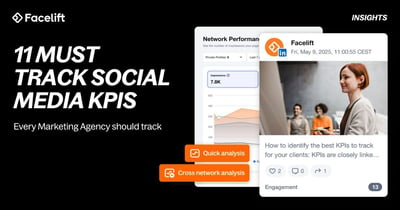Social media orchestration is still often misunderstood.
Some of these misconceptions can keep organizations stuck in outdated workflows, overwhelmed by the growing complexities of managing their strategies, or hesitant to embrace the reality of digital communication that we live in today—and will continue to live in for the foreseeable future.
If your team is hesitating to embrace orchestration, or simply doesn't know what it is, chances are that common misunderstandings are standing in the way. Let’s break them down and show how orchestration can simplify your processes, align your teams, and deliver measurable business results.
Misconception 1: “It’s only for large enterprises.”
Orchestration might sound like something built for global brands with thousands of employees—and it certainly was developed with those enterprises in mind—but the truth about scalability is that it doesn't always mean scaling up. As a result, organizations of any size can benefit.
The truth: Even though it is highly scalable one way or another, orchestration is first and foremost about alignment. Smaller teams can leverage orchestration tools to:
- Streamline communication between marketing, sales, and customer service, even if it's only a handful of people.
- Use centralized content planning to maximize limited resources.
- Drive ROI without adding headcount.
In fact, smaller teams often find orchestration easier to implement because there are fewer silos to break down, and communication doesn't mean reaching out to a team lead on another floor or another building or office. It just means yelling across the room.
When I talk about social media orchestration, it's true that I usually do so through the lens of large enterprises managing multiple offices in multiple countries with dozens - or hundreds - of stakeholders. SMO was really made to cater to their needs, but the philosophy can be shared and used by anyone!
Even a company with 20 employees can benefit from many of the principles of social media orchestration. Companies of this size usually have at least one or two marketers who take the role of social media managers. They likely have sales or account managers who fill a similar role. They'll have at least one executive or business owner, a recruiter or HR person, and more. In fact, at that size, all employees can become valuable voices for their companies.
They must be on the same page, and social media orchestration can get them there.
Misconception 2: “It’s just more work for my team.”
It’s easy to think that orchestration means adding more complexity to workflows, but the opposite is true.
The truth: Orchestration simplifies. It centralizes and unifies tools and workflows, reduces tech stacks, and distributes efforts so that teams save time and reduce duplication. For example:
- Multiple creators planning, editing, and reviewing content in a shared calendar eliminates the back-and-forth of approvals.
- Unified analytics replace piecing together data from multiple platforms.
- Streamlined engagement tools prevent missed mentions or overlapping responses.
Think of orchestration as an investment in efficiency—it eliminates chaos, freeing up your team to focus on creativity and strategy.
Misconception 3: “We’re already doing this with social media management!”
Social media management tools are invaluable for day-to-day tasks, but most of them are simply not built to handle the scope and scale of orchestration. There is certainly overlap, but you can think of social media management as a part of social media orchestration. It is a tactical application rather than a strategic one, and both are necessary for success.
The truth: Management and orchestration serve different purposes.
- Management focuses on tasks: scheduling, publishing, and monitoring. (Tactical)
- Orchestration focuses on alignment: connecting those tasks to broader business goals. (Strategic)
Without orchestration, even the best management tools can’t prevent overlapping campaigns, inconsistent messaging, or siloed data.
Misconception 4: “It’s too expensive.”
Budget constraints often make teams hesitant to explore orchestration tools, but the cost of inefficiency is far greater.
The truth: All managers know that time is money. Orchestration saves money by:
- Replacing redundant tools with vastly more integrated solutions.
- Reducing wasted spend on campaigns that don’t align with strategy.
- Helping you scale without needing to hire more staff.
Social media orchestration is the most cost-effective solution for aligning business goals with communication strategy. Most organizations run a massive stack of tech that includes calendars, chat systems, planner boards, CRMs, CMS, DAMs, and many other abbreviations and acronyms you probably use daily.
They're so expensive! That's hundreds of thousands or millions in [insert local currency here] every year.
Misconception 5: “It’s too complex to implement right now.”
Many teams assume orchestration requires a massive overhaul of their processes, and if one is needed, it can - but it doesn't have to, and starting small can deliver big wins quickly.
The truth: Orchestration is scalable, which doesn't just refer to a company's size. It also means that the organization can begin implementation at its current capacity, whatever that may be.
To begin, start with one or two priorities, like:
- Mapping your social media presence to identify inefficiencies. I wrote a short guide to social media audits to run when implementing social media orchestration (or in general).
- Centralizing your content calendar to improve visibility across teams.
From there, you can gradually build toward a fully orchestrated strategy. Tools like Facelift are designed to make implementation intuitive and customizable for your team’s needs.
Conclusion
Misconceptions about social media orchestration can hold your organization back at the early stages, which are likely the hardest to overcome. But the reality is simple: Orchestration is a smarter, more efficient way to organize and execute social media and content at scale.
Whether you’re a small team or a global enterprise, orchestration helps align your efforts, streamline workflows, and drive measurable results.
Ready to see what orchestration can do for your team? Schedule a demo with Facelift today and let’s take the complexity out of social media orchestration together.






